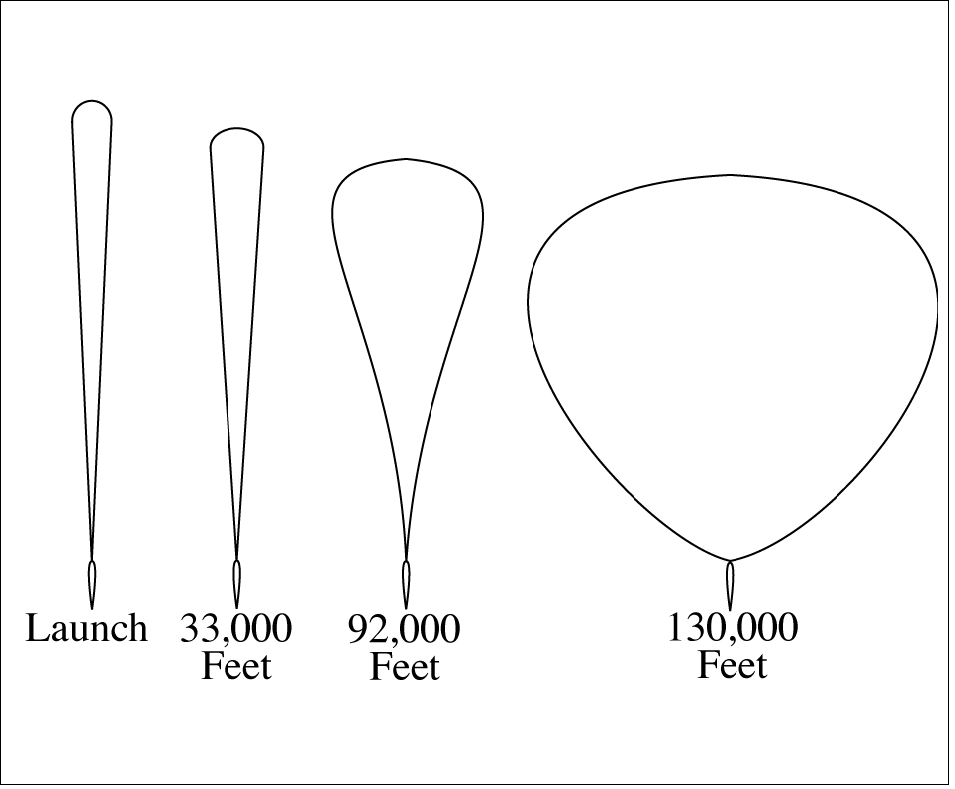Section 6. Unmanned Free Balloons
9-6-1. APPLICATION
FIG 9-6-1
Shapes of 11 Million Cubic Feet Balloon
at Various Altitudes

Apply the following procedures, as appropriate,
when unmanned free balloons are within airspace for
which you have control jurisdiction:
NOTE-
These procedures apply to unmanned free balloons that
carry payloads as described in 14 CFR Section 101.1(a)(4). Payloads may weigh several
hundred pounds and the physical shape of the balloons
change at various altitudes/flight levels. (See FIG 9-6-1.)
Balloon and payload ascend at an average rate of 400 feet
a minute. Over the descent area, the payload is normally
released from the balloon and descends by parachute at a
minimum rate of 1,000 feet a minute. The balloon is
normally deflated automatically when the payload is
released. The operator is required to advise ATC 1 hour in
advance of descent in accordance with 14 CFR
Section 101.39.
a. Post the balloon flight on flight progress strips
along the planned trajectory and revise routing as
tracking/position reports require.
NOTE-
The prelaunch notice information should be posted on
flight progress strips for planning and operational
purposes.
b. Radar flight follow balloons to the extent that
equipment capabilities permit. If radar flight
following is not possible, tracking should be
attempted by communication with the “chase plane,”
telephone contact with the operator, pilot, or ground
observation reports.
NOTE-
Some operators have equipped their balloons with
transponder beacons in addition to a radar reflection
device or material required by 14 CFR Section 101.35, but
at cruise altitude, the balloon's communications equipment
and transponder, if so equipped, are operated intermittently to conserve battery energy.
c. With pilot concurrence, provide separation
between aircraft and balloons when you are satisfied
that the balloon information is sufficiently reliable to
provide the service. Do not attempt to separate
aircraft from the balloon by using vertical separation
unless you have accurate balloon altitude information.
d. Provide traffic advisories to all affected aircraft
during initial contact specifying the balloon's known
or estimated position, direction of movement, and
altitude as “unknown” or “reported,” as appropriate.
NOTE-
Unless ATC requires otherwise, operators of unmanned
free balloons are required to monitor the course of the
balloon and record its position at least every two hours. As
required in 14 CFR Section 101.39a, balloon position
reports are not forwarded by the operator unless requested
by ATC.
PHRASEOLOGY-
UNMANNED FREE BALLOON OVER (name of location),
or
ESTIMATED OVER (name of location), MOVING
(direction of movement).
LAST REPORTED ALTITUDE AT (altitude as reported by
the operator or determined from pilot report),
or
ALTITUDE UNKNOWN.
e. To transfer flight following responsibility of
balloons between facilities or between controllers,
forward the following information when available:
REFERENCE-
14 CFR Section 101.37, Notice Requirements.
14 CFR Section 101.39, Balloon Position Reports.
1. Identification and type; e.g., Flight 804
Balloon.
2. Last known position and altitude.
3. General direction of movement and speed.
4. ETA over facility boundary, sector boundary,
or other point if believed to be reasonably accurate.
5. Other pertinent information.
6. If in radar contact, physically point out the
target to the receiving controller.
7. The name and the telephone number of the
location where tracking is being accomplished.
REFERENCE-
FAAO JO 7110.65, Para 9-6-2, Derelict Balloons.
9-6-2. DERELICT BALLOONS
Balloons become derelict when a moored balloon
slips its mooring and becomes a hazard to air
navigation or when an unmanned free balloon flight
cannot be terminated as planned. When this occurs:
a. In the case of a moored balloon which has
slipped its moorings, issue traffic advisories.
b. In the case of an unmanned free balloon, flight
follow the balloon and, to the extent possible, provide
aircraft under your control separation from the
balloon.
c. Forward balloon position information received
from pilot reports or derived from radar returns to
your supervisor for further dissemination.
d. If radar contact with the balloon is lost,
broadcast an advisory to all aircraft operating in the
airspace affected by the derelict balloon at 10-minute
intervals continuing until the derelict balloon is no
longer a factor.
PHRASEOLOGY-
ADVISORY TO ALL AIRCRAFT.
DERELICT BALLOON REPORTED IN THE VICINITY
OF (location),
or
ESTIMATED IN VICINITY OF (location),
or
REPORTED OVER (location),
or
RADAR REPORTED OVER (location).
LAST REPORTED ALTITUDE/FLIGHT LEVEL AT
(altitude/flight level as reported by operator or pilot
report),
or
ALTITUDE/FLIGHT LEVEL UNKNOWN.
e. Transfer flight following responsibility as
outlined in para 9-6-1, Application, subpara e.
REFERENCE-
FAAO JO 7210.3, Para 18-5-2, Derelict Balloons/Objects.
|
